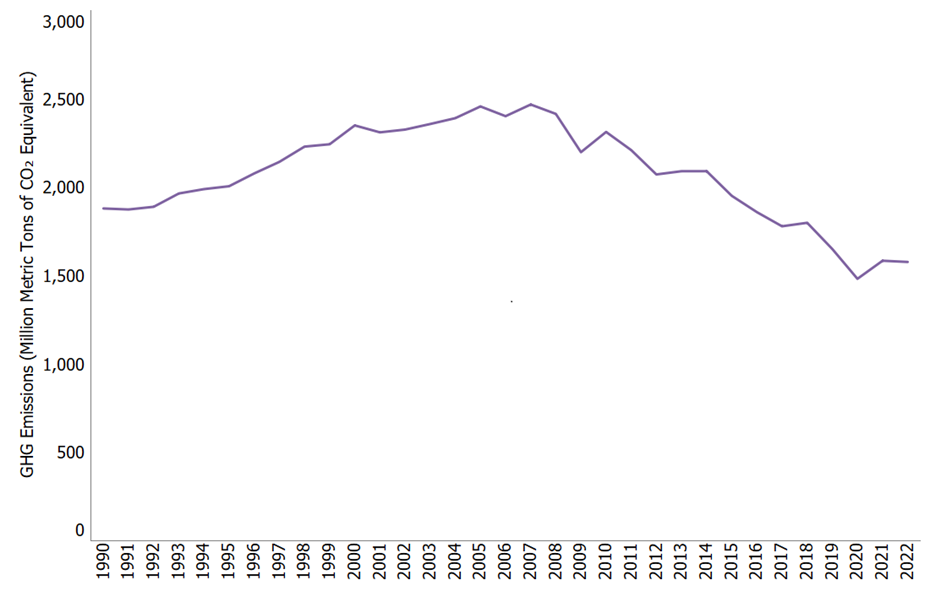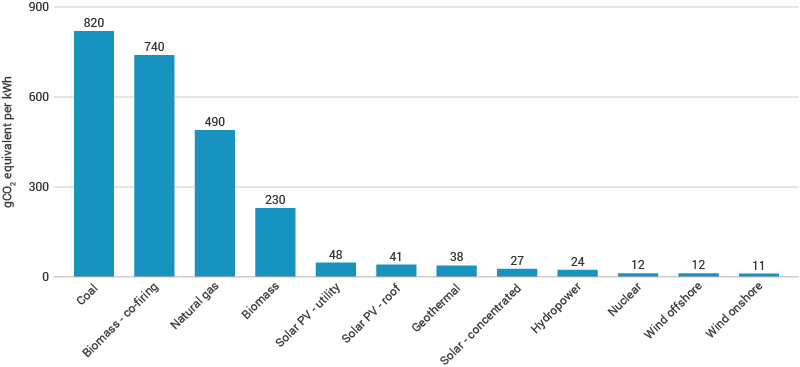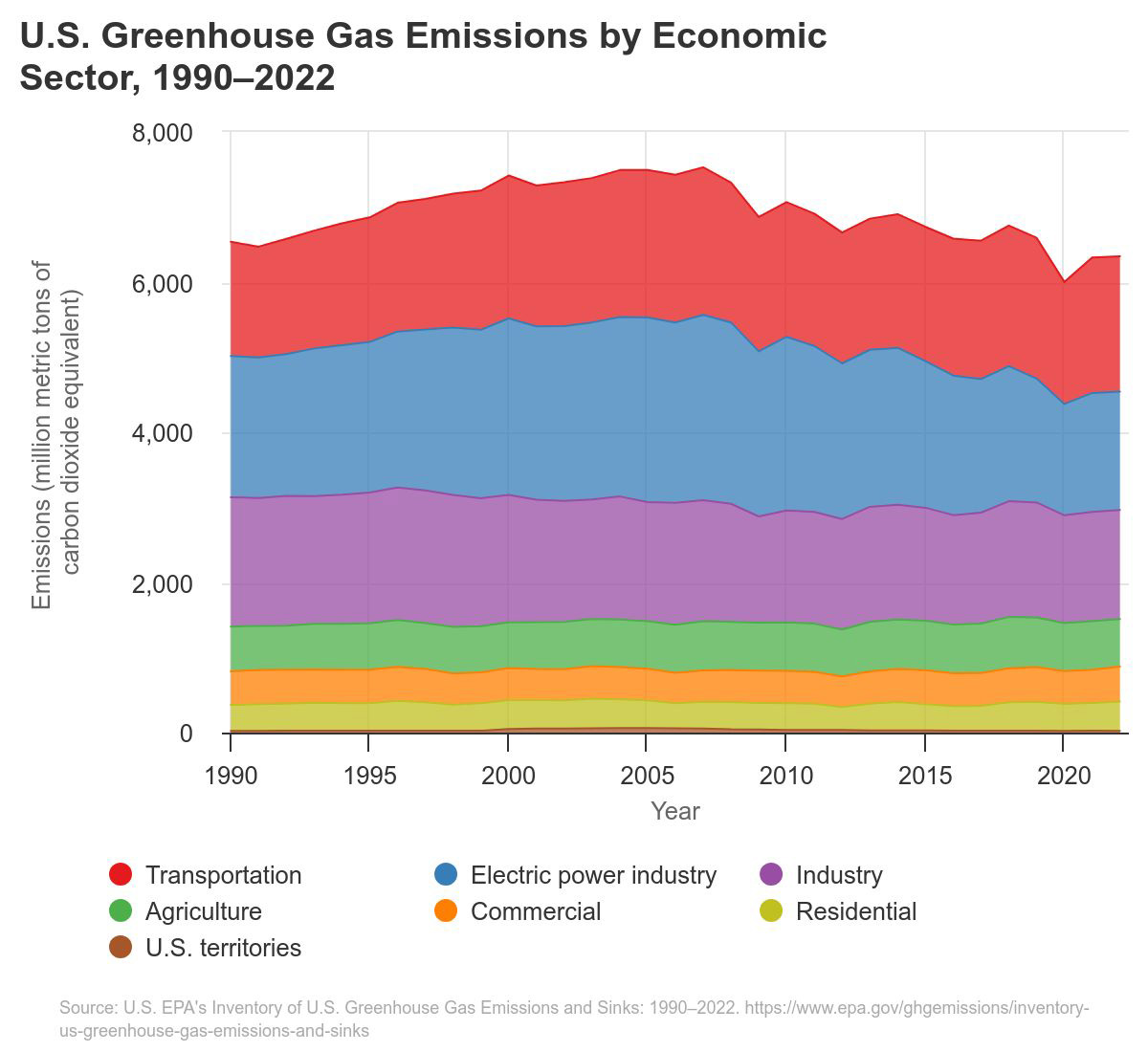Welcome to DU!
The truly grassroots left-of-center political community where regular people, not algorithms, drive the discussions and set the standards.
Join the community:
Create a free account
Support DU (and get rid of ads!):
Become a Star Member
Latest Breaking News
Editorials & Other Articles
General Discussion
The DU Lounge
All Forums
Issue Forums
Culture Forums
Alliance Forums
Region Forums
Support Forums
Help & Search
Environment & Energy
In reply to the discussion: Intersect Power to Build $837M Worth of Grid Batteries in Texas [View all]progree
(11,463 posts)3. I thought we had turned the corner in the U.S. electric power sector on ghg emissions
Last edited Sat Aug 24, 2024, 08:23 AM - Edit history (20)
https://www.epa.gov/ghgemissions/sources-greenhouse-gas-emissionsGreenhouse gas emissions from electric power production have decreased by about 15% since 1990 due to a shift in generation to lower- and non-emitting sources of electricity generation and an increase in end-use energy efficiency.
Edited to add: Since the peak value of 2500 million metric tons of CO2 in 2007, it has fallen 38% to the 1542 million metric tons in 2022 and 43% from 2007 to the 1427 MMT in 2023-- see table below for the 2023 figure /End Edit
Graph title: Greenhouse Gas Emissions from Electric Power, 1990-2022

At bottom of graph: All emission estimates are sourced from the Inventory of U.S. Greenhouse Gas Emissions and Sinks: 1990–2022.
======================================
It shows an uptick in 2021 from 2020, which is probably recovery from the economic shutdowns / recession of 2020. And flat-line from 2021 to 2022 which might be more extraordinary economic recovery keeping it from what would otherwise be a continuing downward trend, hopefully.
It may be that some of the good news since 2007 may have been (besides shifts to solar/wind) is that coal fired generation being retired -- a lot of that was replaced with natural gas fired generation, but nat gas generation has about 60% the ghg per KWH -- see bar graph below (I edited the above ghg per Kwh from 2/3 to 60% End Edit). But that part of the trend may be running out of steam, so to speak, as there aren't as many coal-fired left to retire?
And if the big electric demand forecast increases due to AI and crypto mining actually occur ...
CO2 equivalent emissions, grams/KWH (entire life cycle)
https://world-nuclear.org/information-library/energy-and-the-environment/carbon-dioxide-emissions-from-electricity
The site blocks one from seeing anything with an email solicitation but eventually that goes away, takes at least 30 seconds, grr
On a life-cycle basis, nuclear power emits just a few grams of CO2 equivalent per kWh of electricity produced. Whilst estimates vary, the United Nations (UN) Intergovernmental Panel on Climate Change (IPCC) has provided a median value among peer-reviewed studies of 12g CO2 equivalent/kWh for nuclear, similar to wind, and lower than all types of solar.2

Figure 1: Average life-cycle CO2 equivalent emissions (source: IPCC)
This post has all three of the following:
https://www.democraticunderground.com/1127175045#post3
(#1#) Steel, concrete, glass, and "other" requirements of the various electric power sources per TWH of electricity generated
(#2#) land use efficiency of the various power sources, watts per square meter
(#3#) CO2 equivalent emissions / Kwh (same as above section)
Edited to add
I figured there might be 2023 numbers out there somewhere. I found this, which is CO2 emissions, not total GHG emissions unlike my stuff above, but oh well. Anyway, it shows a 7.4% drop (edited from incorrect 2.7%) in CO2 emissions from the U.S. electric power sector from 2022 to 2023, from 1542 to 1427 million metric tons .
Edited to add: they say some of this drop was due to a mild winter /Edit
https://www.eia.gov/environment/emissions/carbon/
Edited 7/19 630 PM ET to replace the table that was here -- in reverse chronological order -- with a new table in normal chronological order and with the columns lined up. And with the % increase column added /Edit

Data source: U.S. Energy Information Administration, Monthly Energy Review, March 2024, Tables 11.1–11.6
Note: Totals may not equal sum of components due to independent rounding.
EDITED TO ADD: note all the sectors are below their 2019 levels /End Edit
EDITED TO ADD 8/24/24 - Carefully measuring the width of the power sector blue band in the "U.S. Greenhouse Gas Emissions by Economic Sector, 1990-2022" graph BELOW, I find that the GHG emissions from the 2007 peak to 2022 declined by 36.5%.
Late Edited to add the following graph, 7/17 1142 PM ET
https://www.epa.gov/ghgemissions/inventory-us-greenhouse-gas-emissions-and-sinks

Edited to add 7/19 1125 AM ET
I was wondering about the U.S. electrical load -- is some of the reduction of GHG emissions since 2007 in the _U.S._ electric power sector because of a reduction in U.S. electricity production/consumption? I always thought that for the past 2 or more decades electrical demand had been growing slowly like 1% to 2% a year or somesuch. Turns out that it has been virtually flat since 2010
https://www.statista.com/statistics/201794/us-electricity-consumption-since-1975/
bar charts with numbers that pop up when hover mouse
includes direct use (TWH)
2010: 3,887,
...
2019: 3,954 (last pre-pandemic year)
2020: 3,856,
2021: 3,945,
2022: 4,067,
2023: 4,000 TWH.
So in the 13 years from 2010 thru 2023, electrical consumption has grown 2.907%. That's a compound average annual growth rate of 0.221%/year.
Note: yesterday I had full access. This morning, I didn't -- it blocked the graph and most of the page with a notice that I needed a paid account. I tried a different browser. I tried archive.org snapshots in July and December -- same thing. Finally I thought of doing a Google search
https://www.google.com/search?q=U.S.+electricity+consumption+year+by+year
and from the list of results I clicked on the Statista link and wasn't blocked. YMV.
Interesting factoid: Texas is the leading electricity consumption state (470 TWH), followed by California and Florida approximately 250 TWH. So that's some context in the giddy bubbly boo about how Texas is such a great renewable energy state -- they consume (and produce) nearly twice as much total electricity as their nearest rivals.
This one has through 2022
https://www.eia.gov/energyexplained/electricity/use-of-electricity.php
This one through 2023, but doesn't have direct use, which is about 140 TWH/year
https://www.eia.gov/electricity/monthly/epm_table_grapher.php?t=epmt_5_01
((No direct use shown anywhere -Progree))
Electric Power Monthly
Table 5.1. Sales of Electricity to Ultimate Customers:
Nothing in the above is part of a nefarious agenda on my part. I am not saying that since its been essentially flat for more than a decade that it will remain flat. I just felt the picture of ghg of the _U.S._ electric power sector is incomplete without knowing what the electrical production / consumption is. (Production and consumption differ by transmission losses, and probably even "direct use" does not include power plant electricity to run their pumps and pollution control equipment).
I'm mostly just documenting for myself the U.S. electric power power sector, so I can look up all this stuff with the click of a link. Realizing, as always, that the U.S. electric power sector is a small percent of the worldwide total of all sectors in all countries.
EDITED TO ADD 7/20 740 AM ET -
83.9% of U.S energy production is fossil fuel, while wind and solar combine to only 2.3% ughh:
EIA Table 1.2 in interactive: https://www.eia.gov/totalenergy/data/browser/index.php?tbl=T01.02#/?f=A&start=200001
. . . in PDF: https://www.eia.gov/totalenergy/data/monthly/pdf/sec1_5.pdf
TABLE 1.2 PRIMARY ENERGY PRODUCTION BY SOURCE
In 2023, in quadrillion BTUs: Fossil fuels: 86.2325, Nuclear: 8.1008, Wind+solar: 2.3284, Other: 6.0979, Total: 102.7597
So as percentages of total, I calculate:
Fossil: 83.9%, Nuclear: 7.9%, Wind+Solar: 2.3%, , everything else: 5.9%, Total energy: 100%
I'll have to dig into the important details. For example (#1#) on fossil fuel production, does that include net exports? (#2#) And how does one assess the production of a fossil-fueled fired electric power plant (or nuclear power plant), that converts only about 40% of the energy content of the fuel into electrical energy (throwing the other 60% away), as compared to wind and solar that convert these resources straight into electricity? I know some info resources that convert say the 1 TWH output of a wind farm by multiplying it by, say, (100%/40%)= 2.5 TWH of equivalent primary energy. Then they convert to BTU at the theoretically perfect 3412 BTU/KWH (3.412 BTU per watthour) with the result of 8.53 trillion BTUS (or 0.00853 quadrillion BTUs) of equivalent primary energy.
The footnotes on this page probably explains #2 above (where will have to click on some of the links in the footnotes and then read all that crap, but yes, it appears that they do something like what I described above)
. . . https://www.eia.gov/energyexplained/us-energy-facts/
An Exajoule is 10^18 joules. An Exajoule is an SI unit of energy. To get the above quadrillion BTU numbers into Exajoules, multiply the above by 1.055056 EJ per quad. So, for example, the total energy 102.7597 quadrillion BTUs is 108.4172 Exajoules.
ENERGY CONSUMPTION SHARES, 2023: Totals 93.59 quadrillion BTUs. There is a pie chart breakdown of the components. The fossil share is 83%, nuclear is 9%, solar and wind combined is 2.6% and other renewables is 6.4%. The other renewables -- in descending order of size -- are biomass, hydroelectric, and geothermal)
U.S. total annual energy production has exceeded total annual energy consumption since 2019. In 2023, production was about 102.83 quads and consumption was 93.59 quads.
(No explanation for the tiny 0.07 quad difference between this energy production figure of 102.83 quads and the above Table 1.2 value 102.76)
The Energy Consumption shares above is from the pie chart in the us-energy-facts link above
Edit history
Please sign in to view edit histories.
13 replies
 = new reply since forum marked as read
Highlight:
NoneDon't highlight anything
5 newestHighlight 5 most recent replies
RecommendedHighlight replies with 5 or more recommendations
= new reply since forum marked as read
Highlight:
NoneDon't highlight anything
5 newestHighlight 5 most recent replies
RecommendedHighlight replies with 5 or more recommendations
Intersect Power to Build $837M Worth of Grid Batteries in Texas [View all]
Think. Again.
Jul 2024
OP
So does this mean the U.S. is expecting to burn more fossil fuel for electricity generation?
progree
Jul 2024
#1
I thought we had turned the corner in the U.S. electric power sector on ghg emissions
progree
Jul 2024
#3
Added to #3 above: Total U.S. energy production: 83.9% is fossil fuel, only 2.3% is wind and solar
progree
Jul 2024
#13